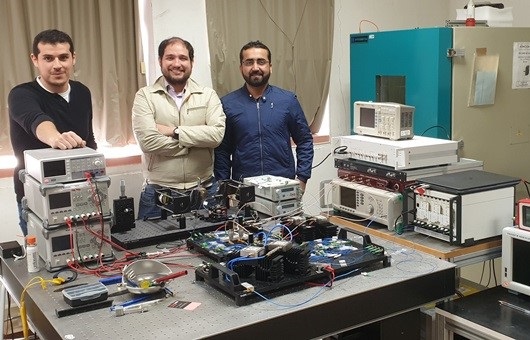Source: Universidad Carlos III de Madrid

The researchers used their new direct hyperspectral dual-comb imaging approach to acquire hyperspectral images of ammonia gas escaping from a bottle. The left image shows a photograph of the scene while the right image shows a map of ammonia transmittance extracted from a single interferogram. The inset shows the spectral response measured by the system at a particular pixel. Credit: Pedro Martín-Mateos, Universidad Carlos III de Madrid
For the first time, researchers have used an advanced analytical technique known as dual-comb spectroscopy to rapidly acquire extremely detailed hyperspectral images. By acquiring a full spectrum of information for each pixel in a scene with high sensitivity and speed, the new approach could greatly advance a wide range of scientific and industrial applications such as chemical analysis and biomedical sensing.
"Dual-comb spectroscopy has revolutionized optical spectroscopy by providing unmatched spectral resolution and accuracy as well as short acquisition times without moving parts," said research team leader Pedro Martín-Mateos from Universidad Carlos III de Madrid, in Spain. "Our new direct hyperspectral dual-comb imaging approach will make it possible to expand most of the point-detection capabilities of current dual-comb systems to create a spectral image of an entire scene."
Dual-comb spectroscopy uses two optical sources, known as optical frequency combs, that emit a spectrum of colors―or frequencies―that are perfectly spaced like the teeth on a comb. As reported in Optica, The Optical Society's journal for high impact research, this is the first time that a dual-comb spectrum has been directly detected using a video camera.
"We demonstrate spectral interrogation of a 2-D object in just one second, more than three orders of magnitude faster than previous demonstrations," said Martín-Mateos. "This fast acquisition time enables dual-comb hyperspectral imaging of fast or dynamic processes, which wasn't possible before."
Although the work was performed using near-infrared wavelengths, the researchers say that the concept can be easily transferred to a variety of spectral regions, widening the number of possible applications.
In particular, expanding the approach to the terahertz and millimeter wave spectral regions would open many new opportunities for nondestructive testing and product inspection in the food, agricultural and pharmaceutical industries. In the mid-infrared and the near-infrared regions it could also enhance the performance of chemical imaging, 3-D mapping and surface topography technologies.

The research team is shown with the optical setup for their new direct hyperspectral dual-comb imaging approach. The method expands the point-detection capabilities of current dual-comb systems to create a spectral image of an entire scene. Credit: Pedro Martín-Mateos, Universidad Carlos III de Madrid
Video-rate detection
Dual-comb spectrometers work by interfering light from two closely matched optical frequency combs. This mixing process generates a signal known as an interferogram at rates that are typically in the tens of megahertz (million times per second), too fast to capture with even the fastest high-speed video cameras.
"We stretched the interferograms generated by our system up to a second to make it possible to detect the dual-comb interference signal using a video camera," explained Martín-Mateos. "This allows the spectral analysis of an entire scene, instead of just a point."
To do this the researchers built a system based on a very simple electro-optic dual-comb source made mostly of optical fiber components. The use of two acousto-optic modulators let them offset the optical combs by an arbitrarily low frequency, to create ultra-slow interferograms.
The researchers used the new method to acquire hyperspectral images of ammonia gas escaping from a bottle. They achieved an optical resolution of 1 GHz (0.0033 cm-1) at video rates of 25 frames per second, with each frame containing 327,680 individual spectral measurements. According to the researchers, the resolution they achieved allows easy distinction between different gases and is 100 times better than current commercial equipment.
"This enables us, for example, to easily identify and distinguish between different gases. The resolution demonstrated in this first experimental demonstration is two orders of magnitude better than that of current commercial equipment.
"Simplicity is one of the main strengths of the system," said Martín-Mateos. "It worked flawlessly and could be implemented in any optics laboratory."
The work is part of a larger project funded by the ATTRACT initiative (Horizon 2020), which aims to develop a fast hyperspectral imaging system that uses the terahertz region of the electromagnetic spectrum for inspection, quality control and classification of agricultural and food products. The researchers are now working to develop a terahertz dual-comb source to demonstrate the method in this spectral region.

